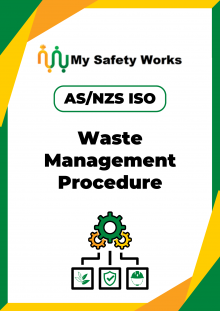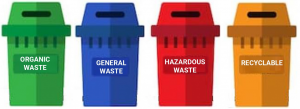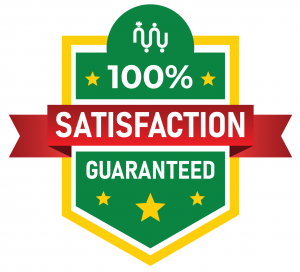
This waste management procedure can assist your business comply with AS/NZS ISO 14001, Environmental Management Systems clauses:
Waste management is an important aspect of any business because the improper disposal of waste can lead to health hazards, environmental pollution and faster depletion of resources.
Workplace waste management is the process of collecting, classifying, processing, transporting and disposal of waste. It can be a complex process, but it is important because improper disposal of waste can lead to health hazards, environmental pollution and depletion of resources.
There are many ways to properly manage waste. Some tips for good waste management practices include:

Having good waste management procedures in place helps protect the environment, human health and conserve our natural resources.
Waste can be described as any material generated that does not have any further use and requires treatment, removal and/or disposal. Waste can be generated from several potential sources and has the potential to pollute the environment if not managed appropriately. A waste management hierarchy requires that waste products be managed in a priority of avoidance, reduction, recycling and disposal.
General waste refers to any material free of any apparent or actual pathological/infectious, radioactive or hazardous chemical contamination. Examples of general waste includes cloth, plastic and styrofoam.
Hazardous waste refers to discarded material, which due to its quantity, concentration, or physical, chemical, or infectious characteristics, may:
Petroleum-based products refers to chemical waste products that have been made from crude oil or its derivatives. These include all oils, greases, organic cleaning solvents or solutions.
Prescribed industrial waste refers to hazardous wastes and wastes that can affect amenities (e.g. odour), generated by industry and listed in relevant legislation (e.g. Prescribed Waste Regulations).
Recyclable waste refers to any discarded material which can be reprocessed for re-use. Recyclable items include paper, cardboard, aluminium cans, glass bottles, scrap metal and recyclable plastic.
Regulated waste refers to wastes that are non-domestic waste generated on-site, as defined by an environmental protection regulation. These wastes must be handled by a registered waste transporter and require disposal at an appropriately licensed facility.
You should not put all your waste into one bin and hope for the best. For proper management planning your waste you need to separate it into categories of waste handling streams. This involves separating the different types of waste so that they can be recycled or disposed of properly.
It is important to do this correctly so that recyclable materials are not sent to landfills, and so that hazardous materials are not mixed with regular waste. There are various ways to separate waste, but the most common method is to use different containers (or bins) for different types of waste.
Appropriate waste collection containers relevant to the types of waste generated must be made available for use. All waste materials must be efficiently contained and when containers are full (or near full) they must be emptied without delay.
All waste material removed from a workplace must be disposed of in an approved manner that is consistent with local and state legislative requirements.
Waste avoidance means reducing the amount of waste you create in the first place. Where possible, the purchase of materials and products should target those that generate less waste and/or materials that can be recycled.
Here are some tips to help you get started.
Note: By following these tips, you can make a significant impact in reducing the amount of waste produced. Not only will this help the environment but, it can also save money.
Note: The dumping of waste and chemical spills (particularly hazardous or medical wastes) in public places or stormwater drains constitutes an offence and any company responsible may be liable to pay for the clean-up costs.
